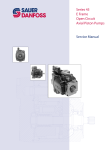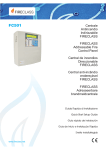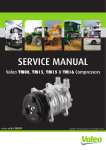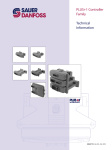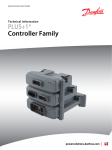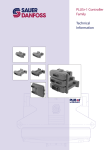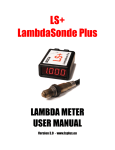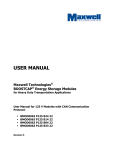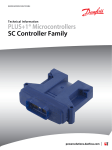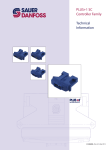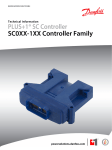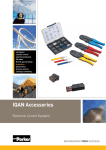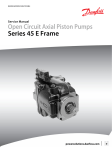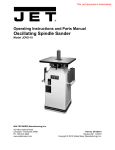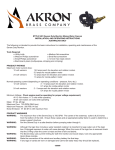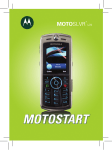Download Series 45 Electronic Torque Limiting Control User Manual
Transcript
MAKING MODERN LIVING POSSIBLE User Manual Electronic Torque Limiting Control Series 45 powersolutions.danfoss.com User Manual S45 ETL Control Revision history Table of revisions 2 Date Changed Rev March 2015 First edition AA L1519202 • Rev AA • March 2015 User Manual S45 ETL Control Contents Overview Purpose of this Manual...................................................................................................................................................................5 Before You Start................................................................................................................................................................................ 5 Literature References.................................................................................................................................................................5 General Electronic Torque Control Information PLUS+1 Compliance........................................................................................................................................................................ 6 Electric Torque Limiting Control Principle.............................................................................................................................. 6 LS Signal Line Orifice..................................................................................................................................................................7 Electronic Torque Limiting Control Characteristic............................................................................................................... 7 System Considerations when Implementing ETL Electronic Torque Limiting and Load Sense Signals............................................................................................................9 Electronic Torque Limiting and Margin Erosion....................................................................................................................9 General Angle Sensor Information PLUS+1 Compliance......................................................................................................................................................................10 Angle Sensor Principle................................................................................................................................................................. 10 Angle Sensor Characteristics..................................................................................................................................................... 10 J & F-Frame (45-90cc) Angle Sensor Identification Convention:............................................................................. 11 E-Frame (100-147cc) Angle Sensor Identification Convention:...............................................................................12 Angle Sensor Electrical Specifications....................................................................................................................................13 Sensor Connector and MC012 Microcontroller Pin Assignments................................................................................ 14 Angle Sensor DTM04-4P Connector Pin Assignments................................................................................................14 Pre-compiled MC012 Pin Assignments............................................................................................................................ 14 Potentiometers, Pressure Transducers, and the PumpTorqCalc Function Block....................................................15 Potentiometer............................................................................................................................................................................15 Pressure transducer................................................................................................................................................................. 15 General PLUS+1 ETL Service Tool Information System Overview............................................................................................................................................................................18 Torque Limit Setpoint...................................................................................................................................................................18 Torque Limit Setpoint Parameters..................................................................................................................................... 18 ETL Service Tool Setup Additional Setup Angle Sensor Calibration.............................................................................................................................................................19 Angle Sensor Calibration Parameters................................................................................................................................20 Establish the Minimum Pump Displacement................................................................................................................. 20 Establish the Maximum Pump Displacement with Engine Off................................................................................ 21 Establish the Maximum Pump Displacement with Engine Running..................................................................... 21 Pump Setup......................................................................................................................................................................................22 Pump Setup Parameters........................................................................................................................................................ 23 Define Pump Displacement..................................................................................................................................................23 RPM Input Setup.............................................................................................................................................................................24 RPM Input Parameters............................................................................................................................................................ 24 Perform RPM Input Setup......................................................................................................................................................24 Torque Potentiometer Calibration.......................................................................................................................................... 25 Torque Potentiometer Calibration Parameters............................................................................................................. 25 Calibrate Torque Potentiometer......................................................................................................................................... 25 Pressure Sensor Setup..................................................................................................................................................................26 Pressure Sensor Setup Parameters.....................................................................................................................................26 Select Pressure Sensor Setup............................................................................................................................................... 26 Torque Limit Profile Setup..........................................................................................................................................................27 Torque Limit Profile Setup Parameters.............................................................................................................................28 Establish Torque Limit Profile with Torque Curve........................................................................................................ 28 Establish Torque Limit Profile without Torque Curve................................................................................................. 29 Adjust Torque Setpoints........................................................................................................................................................ 29 Considerations for Establishing the Torque Limit Profile.......................................................................................... 30 Boost Mode...................................................................................................................................................................................... 31 Boost Mode Parameters......................................................................................................................................................... 31 L1519202 • Rev AA • March 2015 3 User Manual S45 ETL Control Contents CAN Torque Setpoint Setup.......................................................................................................................................................32 Command Filter Setup................................................................................................................................................................. 32 Command Filter Setup Parameters....................................................................................................................................34 Troubleshooting 4 Pressure Setpoint Faults.............................................................................................................................................................. 35 Electrical Interface..........................................................................................................................................................................35 L1519202 • Rev AA • March 2015 User Manual S45 ETL Control Overview Purpose of this Manual This manual is intended to be a reference for customers using Danfoss S45 Open Circuit Axial Piston Electronic Torque Limiting (ETL) pumps in conjunction with the keyed ETL MC012 and PLUS+1® Guide Subsystem Application Block. The setup and operation of the PLUS+1® ETL software will be illustrated with S45 ETL pumps by utilizing the ETL PLUS+1® service screens. Before You Start Users setting up an ETL system with both PLUS+1® software and S45 Open Circuit ETL pumps should have a working knowledge of basic hydraulic systems, principles, and PLUS+1® Service Tools. Users should also have access to PLUS+1® and S45 technical literature. Literature References Useful technical information on pump displacements, controls specifications, software, and operating condition requirements can be found in the following literature. Literature references Literature type Literature title Literature number Technical Information Series 45 Axial Piston Open Circuit Pumps 520L0519 Service Manual Series 45 Frame J Open Circuit 520L0607 Series 45 Frame F Open Circuit 11005158 Series 45 Frame E Open Circuit 520L0606 Parts Manuals Repair Instructions Series 45 Frame J 520L0585 Series 45 Frame F 11007197 Series 45 Frame E 520L0584 Series 45 Frame J Open Circuit 520L0610 Series 45 Frame F Open Circuit 520L0821 Series 45 Frame E Open Circuit 520L0609 User Guide PLUS+1® Service Tool User Manual L1307770 (Also found under Help on toolbar) Data Sheet PLUS+1® Controllers MC012-110 and MC012-112 L1301095 Product Electrical Installation MBS1250 Heavy Duty Pressure Transmitter 11062087 L1519202 • Rev AA • March 2015 5 User Manual S45 ETL Control General Electronic Torque Control Information PLUS+1 Compliance All Series 45 Electric controls have met and passed the Danfoss PLUS+1 compliance standard testing, and as such, this Series 45 control is PLUS+1 compliant. PLUS+1 compliance blocks are available on the Danfoss website, within the PLUS+1 Guide section. Electric Torque Limiting Control Principle The Electronic Torque Limiting control consists of a normally closed proportional relief valve (PRV) integrated into a Pressure Compensated/Load Sensing control. This control operates as a PC/LS control, with the additional ability to limit load sense pressure using the integrated PRV by varying the current to the solenoid. When combined with an angle sensor, this control allows for a PC/LS control with electronic torque limiting. J-frame pump with integrated ETL control P108779 Pump torque consumption is a function of pump outlet pressure, pump displacement, and pump mechanical efficiency. When pump mechanical efficiency is considered constant, the pump torque can be limited when pump displacement is known and pump pressure is controlled. As pump displacement increases, the pump outlet pressure can be limited using the PRV to result in a constant torque limit. 6 L1519202 • Rev AA • March 2015 User Manual S45 ETL Control General Electronic Torque Control Information Pump outlet pressure is equal to the load sense pressure, which is limited with the PRV, plus the margin pressure setting of the pump. LS Signal Line Orifice S45 Electronic Torque Limiting Controls require the use of an LS signal line orifice. The LS signal line orifice is used to enhance system stability, as well as allow the limiting of torque throughout the full range of pump pressure and flow. The standard 0.8 mm orifice is best suited for use in a wide variety of applications. Please contact your Danfoss representative for further information on the availability of additional LS signal line orifice sizes. Electronic Torque Limiting Control Characteristic The Electronic Torque Limiting control allows users to limit pump torque consumption electronically by combining a pressure limiting PRV and angle sensor. This torque limit can be changed with varying engine speeds (as shown in the Electronic Torque Limiting graph below), allowing the use of full engine torque at all engine speeds and increasing machine productivity. A microcontroller is required to store engine torque vs speed, receive the pump angle sensor signal, and then calculate and output the pump outlet pressure limit. The basic torque limiting control logic for a single engine speed is shown below. Danfoss offers a PLUS+1 subsystem application block for the Electronic Torque Limiting control option in combination with keyed MC-12 microcontroller hardware. Electronic Torque Limiting Pump Pressure (bar) 300 250 200 150 Speed 1 100 Speed 2 Speed 3 50 0 0 50 100 150 200 Pump Displacement (cc) P108783 L1519202 • Rev AA • March 2015 7 User Manual S45 ETL Control General Electronic Torque Control Information Basic ETL Control Logic 350 600 500 250 400 200 300 150 200 100 100 50 0 0 5 10 15 20 25 30 35 40 45 Pump Displacement (cc) Maximum System Pressure - ETL Active (bar) 8 Current to Valve (mA) Maximum System Pressure (bar) 300 L1519202 • Rev AA • March 2015 Current to Valve (mA) 50 0 P108785 User Manual S45 ETL Control System Considerations when Implementing ETL When setting up an ETL system to function properly, you must account for LS signal line orificing and margin erosion. Electronic Torque Limiting and Load Sense Signals Danfoss PVG valves, as well as many competitor valves, are manufactured with LS signal line orifices installed in the pump inlet (PVP) module. These orifices enhance system stability by dampening the highest load pressure signal before it is relayed to the open circuit pump. They also help limit the amount of flow over the load sense relief valve inside the PVP. It is important to ensure that when using these LS line orifices the highest resolved load sense pressure is communicated to the pump or loss of some flow sharing functionality may occur. If you experience symptoms of loss of flow sharing, some troubleshooting steps may include removing the LS line orifice in the valve stack, or ensuring that the LS pressure rails are connected to each other when using two or more different valve stacks. In this way, the highest load from the system is communicated to the pump. Electronic Torque Limiting and Margin Erosion A potential flow sharing problem may arise when several functions are actuated at the same time and require a high flow demand from the pump. This problem may include a loss of movement in the highest pressure function when many functions are actuated at the same time. This problem is margin erosion. Margin erosion is caused when margin pressure is shifted from the operator-controlled valves to the LS signal line orifice in the S45 pump. When this margin shifts too much, the valve cannot flow share correctly. Danfoss PVG valve groups reduce this problem with compensator valves which remain open at a very low margin pressure. This allows more aggressive torque limiting, particularly at low engine idle speeds where torque limiting is most critical. In addition to using valves with superior low pressure flow sharing characteristics, it is possible to use calculations to identify problem areas where margin erosion can become a concern. Please contact your Danfoss representative for more information on calculating and planning for margin erosion. L1519202 • Rev AA • March 2015 9 User Manual S45 ETL Control General Angle Sensor Information PLUS+1 Compliance The Electric Angle Sensor has met and passed the Danfoss PLUS+1 compliance standard testing, and as such, this Angle Sensor is PLUS+1 compliant. PLUS+1 compliance blocks are available on the Danfoss website, within the PLUS+1 Guide section. Angle Sensor Principle The Series 45 Angle Sensor option allows users to measure the angle of pump displacement. The angle sensor is an electronic sensor mounted to the housing of the pump, which reads the pump stroke angle based on the swashplate position. Interfacing with the angle sensor is achieved through a 4-pin Deutsch DTM04-4P receptacle attached to a flexible connection cable (for a mating connector, use Deutsch® plug DTM06-4S). The sensor is mounted to the pump within an aluminum housing to prevent magnetic interference. AMR Sensor Swashplate Magnet Carrier Deutsch Plug P108788 Angle Sensor Characteristics The angle sensor package incorporates two sensor signals (primary & secondary), within a single sensor housing. This allows for improved accuracy and troubleshooting. For the ‘Angle Sensor – Right’ order code in the K module, the sensor is positioned according to the following conventions. 10 L1519202 • Rev AA • March 2015 User Manual S45 ETL Control General Angle Sensor Information J & F-Frame (45-90cc) Angle Sensor Identification Convention: When looking at the input shaft with the control on the ‘top’ side, the angle sensor will be viewed on the right hand side. This convention is true for both Clockwise and Counter-clockwise rotation J & F-Frames. 86.8 [3.417] 43.5 [1.71] 36 [1.417] 37.1 [1.462] 42.5 [1.67] 30.5 [1.2] 94.1 [3.704] 29.5 [1.16] 37.1 [1.462] 87.3 [3.44] 36 [1.417] 93.6 [3.68] J Frame Angle Sensor Position F Frame Angle Sensor Position P108816 This sensor location yields a unique voltage versus swashplate angle characteristic curve which is the same for both Clockwise and Counter-clockwise rotation J & F-frames. Although each pair of curves will be unique for individual pumps, a general example of what to expect is provided below for J & F units with the ‘Right’ angle sensor position. Sensor Output Voltage vs. Swashplate Angle CW & CCW J & F-Frames (45-90cc) Primary Output Voltage Secondary Output Voltage 5 4.5 Sensor Output (Volts) 4 3.5 3 2.5 2 1.5 1 0.5 0 0 1 2 3 4 5 6 7 8 9 10 11 12 13 14 15 16 17 18 Swashplate Angle (Degrees) P108817 L1519202 • Rev AA • March 2015 11 User Manual S45 ETL Control General Angle Sensor Information E-Frame (100-147cc) Angle Sensor Identification Convention: The location convention for the E-Frame angle sensor is different from that of the J & F-Frame due to a difference in design of the endcap and servo systems. When looking at the input shaft, the angle sensor will be positioned on the same side as the outlet port of the endcap. The outlet port of the endcap is always the smaller of the inlet and outlet ports, indicated below. This is the ‘right side’ order code location, even though it appears on the left hand side from a frontal view. 36 [1.42] 36 [1.42] Outlet Port 59.4 [2.34] 126.9 [5.0] 120 [4.72] Approximate Wire Length 131.5 [5.18] E Frame Angle Sensor Position P108821 Clockwise rotation E-frames appear with the control on the top side in this view. Counter-clockwise rotation E-Frames appear with the control on the bottom side in this view. This sensor location yields a unique voltage versus swashplate angle characteristic curve which is different for Clockwise and Counter-clockwise rotation E-frames. Although each pair of curves will be unique for individual pumps, a general example of what to expect is provided below for both Clockwise and Counter-clockwise rotation units with the Right angle sensor position. 12 L1519202 • Rev AA • March 2015 User Manual S45 ETL Control General Angle Sensor Information Sensor Output Voltage vs. Swashplate Angle CW E-Frames (100-147cc) Primary Output Voltage Secondary Output Voltage 5 4.5 Sensor Output (Volts) 4 3.5 3 2.5 2 1.5 1 0.5 0 0 1 2 3 4 5 6 7 8 9 10 11 12 13 14 15 16 17 18 Swashplate Angle (Degrees) P108823 Sensor Output Voltage vs. Swashplate Angle CCW E-Frames (100-147cc) Primary Output Voltage Secondary Output Voltage 5 4.5 Sensor Output (Volts) 4 3.5 3 2.5 2 1.5 1 0.5 0 0 1 2 3 4 5 6 7 8 9 10 11 12 13 14 15 16 17 18 Swashplate Angle (Degrees) P108822 Angle sensor electrical specifications Electrical specifications Description Minimum Typical Maximum Unit Note Supply (V+) 4.75 5 5.25 Vdc Sensor is ratiometric in the voltage range L1519202 • Rev AA • March 2015 13 User Manual S45 ETL Control General Angle Sensor Information Electrical specifications (continued) Description Minimum Typical Maximum Unit Note Supply protection — — 28 Vdc Sensor will switch off above 5.5 V Supply current drawn — 22 25 mA Sensor supply at 5 V Output short circuit current (VDD to SIG 1/2 and GND to SIG 1/2) — — 7.5 mA Additional 7.5 mA for each sensor signal, total sensor 7.5x2+22=37 mA typical for FSO Sensitivity in sensing range at calibration temperature for primary and secondary sensor 70.02 78 85.8 mV — Resolution — 0.03 — degree 11 bit output channel Hysteresis — — — — Design of sensor eliminates any mechanical hysteresis Environment temperature range -40 (-40) 80 (176) 104 (220) °C (°F) If temperature limits are exceeded, the sensor will function at a reduced level of performance Operating temperature range 20 (68) 50 (122) 95 (203) °C (°F) Temperature of oil Storage temperature -40 (-40) — 125 (257) °C (°F) — Accuracy for primary and secondary signals throughout operating temperature range when calibrated at 50 deg. C — Primary: ±0.65 Secondary: ±0.85 — degree Includes linearity, temperature drift, and repeatability. Does not include the error due to offsets and different ferrous environment Refresh rate of the sensor — — 100 μs Internal ADC refresh rate Sensor Connector and MC012 Microcontroller Pin Assignments Angle Sensor DTM04-4P Connector Pin Assignments For a mating connector, use Deutsch® plug DTM06-4S. 4 1 3 2 P108760 Pin Assignment 1 Ground (GND) 2 Output signal 2 (SIG2) - Secondary signal 3 Output signal 1 (SIG1) - Primary signal 4 Supply (V+) Pre-compiled MC012 Pin Assignments 12-pin connector 1 2 3 4 5 6 12 11 10 9 8 7 2200B 14 L1519202 • Rev AA • March 2015 User Manual S45 ETL Control General Angle Sensor Information Pre-compiled MC012 Pin Assignments Pin callout Pin assignment type ETL function assigned C1-P1 Power ground (–) Generic/sensor ground C1-P2 Power supply (+) Machine power C1-P3 CAN (+) CAN/J1939 High C1-P4 CAN (–) CAN/J1939 Low C1-P5 AIN/CAN shield Pressure transducer signal (optional) C1-P6 5Vdc sensor power (+) Angle sensor power (mandatory) Pressure transducer power (optional) Torque potentiometer power (optional) C1-P7 Sensor power ground (–) Generic/sensor ground C1-P8 DIN/AIN/FreqIN Angle sensor signal 1 (mandatory) C1-P9 DIN/AIN/FreqIN Angle sensor signal 2 (optional) RPM speed ring pickup Boost mode switch functionality C1-P10 DIN/AIN/FreqIN Potentiometer wiper (optional) C1-P11 PWMOUT/DOUT/PVGOUT User function C1-P12 PWMOUT/DOUT/PVGOUT Control coil current supply Potentiometers, Pressure Transducers, and the PumpTorqCalc Function Block Potentiometer It is possible to use a potentiometer to control the torque limiting signal for ETL setup purposes. Use a 1kohm potentiometer with a 120-ohm resistor on the +V and –V ends. Pressure transducer Using a pressure transducer allows the ETL service tool to report actual torque and power consumed by the S45 pump via the PumpTorqCalc Funcion Block. The PumpTorqCalc function block is an optional part of the ETL system, and it allows the user to report real-time data on a graphical display terminal to help equipment operators understand and improve operating efficiencies or share data between subsystems to coordinate power sharing. For more detailed information on the PumpTorqCalc Function Block, see Work Function Control Blocks Library (L1313265). Danfoss recommends using the MBS1250 Heavy Duty Pressure Transducer with a measuring range of 0 to 400 bar [5800 psi]. For information on this transducer, see MBS1250 Heavy Duty Pressure Transmitter Product Electrical Installation (11062087). L1519202 • Rev AA • March 2015 15 User Manual S45 ETL Control General PLUS+1 ETL Service Tool Information The Electronic Torque Limiting (ETL) Service Tool is used to set up the torque limiting functionality on a machine. See ETL Service Tool Setup on page 19 for the steps required to set up an ETL system. Typical ETL Service Tool Screen shows a typical ETL Service Tool screen. You can navigate the Service Tool screens in two ways. • Diagnostic Navigator Panel (1), which allows you to view the hierarchy of all screens • Navigation buttons (2), which give you quick access to related screens ETL functionality is listed under Diagnostic Navigator > Parameter Functions (3). System Overview ‒ Torque Limit Setpoint Torque Potentiometer Calibration Torque Limit Profile Setup Torque Setpoint CAN Torque Setpoint Setup ‒ Command Filter Setup ‒ Angle Sensor Calibration ‒ Boost Setup ‒ RPM Input Setup ‒ Pump Setup ‒ Pressure Sensor Setup ‒ Pressure Setpoint Faults ‒ Electrical Interface • User-defined toggle inputs (4) appear with a blue background. Parameter faults (5) are shown as green, if no fault is present, and red, if a fault is present. Each screen includes navigation links back to the System Overview (6), bounded by red. Outputs (7) appear on all ETL Service Tool screens. 16 L1519202 • Rev AA • March 2015 User Manual S45 ETL Control General PLUS+1 ETL Service Tool Information Typical ETL Service Tool Screen Typical ETL Service Tool Outputs Output Description Torque Limit Setpoint Displays the real-time calculated torque limit for the real-time engine speed as a percentage of maximum torque consumable by the pump. It is calculated based on the curve fitted from the torque limit profile (discussed on torque limit profile page) or as an input of the voltage from the Torque Potentiometer. Engine Speed Shows the real-time engine speed fed back from the machine. Engine speed feedback must be wired to the microcontroller by the user using either the CAN High and CAN Low pins (C1-P3 and C1-P4), or the RPM speed ring pickup pin (C1-P9) (see RPM Input Setup on page 24). Pressure Setpoint Displays the real-time system pressure currently allowed by the ETL control system. Displayed both as a percentage of Max Pump Pressure and in bar. It is calculated by referencing current pump displacement and engine speed (torque available at engine). Control Current Displays real-time current in milliamps (mA) being sent to the pump’s control solenoid from the PLUS+1® microcontroller. A current of zero or near-zero mA indicates that the solenoid is not being activated to limit torque. Torque Consumed Displays the real-time torque consumed by the pump as a calculated percentage of pump maximum torque based on the Max Pump Displacement and Max Pump Pressure inputs. Power Consumed Displays the real-time power consumed by the pump as a calculated percentage of pump maximum power based on the Max Pump Displacement, Max Pump Pressure, and Max Pump Speed. Displacement Displays the real time pump displacement in both percent of maximum displacement and cm3/rev. This displacement depends directly on the minimum and maximum displacement calibration points. Pressure Indicates real-time system pressure based on a pressure transducer. Note that a pressure transducer must be added to the system by the user for this optional functionality. L1519202 • Rev AA • March 2015 17 User Manual S45 ETL Control General PLUS+1 ETL Service Tool Information System Overview The System Overview screen is the home screen for the ETL Service Tool. This screen shows a high-level overview of how the S45 ETL software ties into the machine’s engine and hydraulic systems by reporting real-time parameters. You can also use the System Overview to do the following actions. • Navigate to each ETL functionality to tune changes or conduct diagnostics after the general setup • Enable or disable ETL Control using the Toggle button ETL System Overview Screen Torque Limit Setpoint The Torque Limit Setpoint screen is important because it allows the user to select between two torque limit input options (Torque Limit Profile or Torque Potentiometer). This screen also provides quick navigation to the most frequently used setup screens. Torque Limit Setpoint Parameters Torque Limit Setpoint Parameters Inputs 18 Torque Limit Input Allows the user to select between two different forms of torque limitation controls, Torque Profile and Potentiometer. The Torque Profile is used when the seven limiting setpoints are finalized, and the Potentiometer is used when first setting up ETL or conducting diagnostics. These are discussed in detail in Torque Limit Profile Setup on page 27. Maximum Torque Allowed Allows the user to de-rate the whole Torque Limit Profile by a common factor. The software sets the default value to 100%. L1519202 • Rev AA • March 2015 User Manual S45 ETL Control ETL Service Tool Setup This section describes the ETL functions that are required for the ETL system to operate, including how to set up each ETL function. To set up each ETL function, you will make changes to each function's respective ETL Service Tool screen, similar to the screen shown in Typical ETL Service Tool Screen. The following steps are required in order for the ETL system to operate. 1. Calibrate Angle Sensor a. Establish the Minimum Pump Displacement on page 20 b. Establish the Maximum Pump Displacement with Engine Off on page 21 or 2. 3. 4. 5. 6. Establish the Maximum Pump Displacement with Engine Running on page 21 Define Pump Displacement on page 23 Perform RPM Input Setup on page 24 Calibrate Torque Potentiometer on page 25 Select Pressure Sensor Setup on page 26 Establish Torque Limit Profile • Establish Torque Limit Profile with Torque Curve on page 28 or Establish Torque Limit Profile without Torque Curve on page 29 Angle Sensor Calibration A fundamental step in setting up ETL is to calibrate your angle sensor. The calibration will ensure accurate angle sensor voltage readings based on maximum and minimum pump displacements (swashplate angles). Calibration does not inform the software what the physical maximum displacement of the pump is in terms of engineering units. This is done in the Pump Setup Parameters screen, and the correct calibration of the angle sensor is independent of the Max Pump Displacement input. It is possible when calibrating the angle sensor that the Minimum Displacement Voltage is greater than the Maximum Displacement Voltage. This is due to the different relationships between swashplate angle and voltage for J and F-frames versus E-frame pumps. For more information, see the Angle Sensor Characteristics on page 10. L1519202 • Rev AA • March 2015 19 User Manual S45 ETL Control ETL Service Tool Setup Angle Sensor Calibration Screen Angle Sensor Calibration Parameters Angle Sensor Calibration Parameters Calibration Inputs Faults Minimum Pump Displacement Records the angle sensor signal voltage that corresponds to the pump’s lowest displacement condition Maximum Pump Displacement Records the angle sensor signal voltage that corresponds to the pump’s highest displacement condition C1p08-Primary Signal Displays the real-time voltage signal from the primary sensor pickup C1p09-Secondary Signal Displays the real-time voltage signal from the secondary sensor pickup, if enabled (optional) Calibration/Parameter Faults Minimum/Maximum displacement not calibrated Invalid setup/calibration Parameter out of range Sensor Input Faults Signal 1 input too low/high Signal 1 input at Sensor Power/Ground Redundant signal indicates error Establish the Minimum Pump Displacement To establish the minimum displacement of the pump, you must operate the pump at either the Low Pressure Standby Condition (LPSB) or the High Pressure Standby Condition (HPSB). For the best results, calibrate and compare using both LPSB and HPSB to achieve the lowest (or highest, for CW E-frame units) captured voltages. 20 L1519202 • Rev AA • March 2015 User Manual S45 ETL Control ETL Service Tool Setup It is important to compare the minimum displacement voltage readings at both LPSB and HPSB. Generally, the swashplate angle is lower at LPSB because there are lower leakages at lower pressures, so lower displacements are required to make up the leakages. This is not true when some flow is allowed past the main valve block at LPSB. Then, HPSB conditions become preferred. Although the leakages are higher at higher pressures, the increase in flow due to leakages is lower than the flow allowed by the main valve. 1. Set the engine at full operating speed. The engine must be operated at full speed to prevent an inaccurate displacement reading. 2. If the ETL is not disabled in the System Overview screen, toggle ETL Control to Disabled. The control current should approximate 0 mA. 3. Operate the pump at one or both of the following conditions. Condition When to use Low Pressure Standby Condition (LPSB) Use when the machine’s main valve block completely shuts off flow to any downstream components (zero flow needed by machine functions/valves from pump) High Pressure Standby Condition (HPSB) Use when the machine’s main valve block does not completely shut off flow to all downstream components (some small flow needed by machine functions/valves from pump at all times, even with no operator command) a) If using LPSB, let the machine stand at full engine speed without operating any functions. This allows the pump to de-stroke naturally because no flow is commanded from the pump, and system pressures will be only slightly higher than the pump’s LS setting. b) If using HPSB, operate a machine function over a hard-stop and reach full pressure compensator (PC) setting with system pressure. This allows the pump to de-stroke by porting high pressure oil to servo. From the Angle Sensor Calibration screen while maintaining either LPSB or HPSB: 4. Click Minimum Pump Displacement > Capture Voltage. Establish the Maximum Pump Displacement with Engine Off 1. Turn off the machine. 2. Momentarily jog the starter to turn the pump shaft a few revolutions, without actually running the engine. This allows the pump’s swashplate to return to its naturally spring biased full-stroke position by overcoming residual pressure and friction in the swashplate and servo system. From the Angle Sensor Calibration screen: 3. Click Maximum Pump Displacement > Capture Voltage. Establish the Maximum Pump Displacement with Engine Running The engine must be operated at full speed to prevent an inaccurate displacement reading. 1. Operate the pump in a full displacement, full flow, and low load machine condition. a) Operate engine at full operating speed. b) Command a single high flow function or multiple machine functions simultaneously while remaining below the pump’s pressure compensator setting (low system pressure). Do not reach or exceed the pressure compensator setting or the pump will begin to de-stroke and reduce its displacement and render a bad maximum displacement reading. From the Angle Sensor Calibration screen: 2. Click Maximum Pump Displacement > Capture Voltage. L1519202 • Rev AA • March 2015 21 User Manual S45 ETL Control ETL Service Tool Setup Pump Setup The pump setup function defines the pump displacement in PLUS+1® software. It also sets the maximum system pressure and maximum pump speed to calculate the maximum pump torque and power. Coil current thresholds are also set up based on the user's inputs. Pump Setup Screen 22 L1519202 • Rev AA • March 2015 User Manual S45 ETL Control ETL Service Tool Setup Pump Setup Parameters Pump Setup Parameters Inputs Faults Max Pump Pressure Defines the maximum desired system pressure created by the pump, in bar. This must be less than or equal to the Pressure Compensator (PC) setting. This software setting DOES NOT override the pump’s factory set mechanical Pressure Compensator setting. If the Max Pump Pressure is higher than the PC setting, the pump will default to the physical PC pressure of the pump and the ETL system will not function correctly. Max Pump Speed Calculates power consumed by the pump. Generally, the highest engine operation speed of the machine should be used. See Series 45 Pumps Technical Information (520L0519) for allowed pump operating speeds in order to ensure conformance to recommended continuous operation speeds. This input does not limit physical pump speed in any way. Max Pump Displacement Defines the true maximum displacement of the pump in terms of cm3/rev and correlates it to the Maximum Captured Voltage. Also known as nominal pump displacement, it can be determined by the pump’s model code. LS pressure setting Defines the margin setting of the pump, in bar. This must be equal to the LS pressure setting as defined from the factory. This may be found on the pump's identification tag. Threshold current Defines the minimum current required for active torque limiting in the control. It is based on the Max Pump (PC) Pressure, LS Pressure Setting, and 12- vs. 24-volt coil characteristics. This is an interpolated value that references control pressure vs. current curves. Parameter input faults Max Pump Pressure out of range Max Pump Speed out of range Max Pump Displacement out of range Input faults Displacement value too high or low Speed value too high or low Pressure value too high or low Define Pump Displacement From the Pump Setup screen: 1. Set Pump Max Pressure to the desired maximum operating pressure. The Pump Max Pressure setting must not exceed the Pressure Compensator (PC) setting of the pump. It should be equal to or less than the PC setting, or else the system will lose power because the pump will need to relieve pressure in a constant manner. 2. Set LS Pressure Setting to the pump's factory LS margin pressure. 3. Set Max Pump Speed to the maximum operating speed at which the pump will operate. In general, you should use the highest engine operation speed of the machine. See Series 45 Pumps Technical Information (520L0519) for allowed pump operating speeds to conform to the recommended continuous operation speeds. 4. Set Max Pump Displacement to the physical maximum displacement of the pump in units of cm3/ rev. 5. Set Threshold Current. a) Toggle Coil Setup to the correct coil voltage. b) Set Max Pump (PC) Pressure and LS Pressure Setting. The Recommended Threshold field will display the recommended threshold. c) Select Use Recommended. The recommended current threshold will transfer to the Threshold Current field. Advanced users may reference a control pressure vs. current curve and enter their own threshold to create a custom offset for the threshold setting. L1519202 • Rev AA • March 2015 23 User Manual S45 ETL Control ETL Service Tool Setup RPM Input Setup The RPM input limits the torque throughout an engine’s usable speed range. To set up this limit, you must select the proper speed input, either CAN bus speed pickup or speed ring pulse pickup. RPM Input Setup Screen RPM Input Parameters RPM Input Parameters Inputs Speed Input Pulse Per Revolution Faults Toggle switches between two different inputs: CAN bus and Speed ring pulse pickup Sets the number of pulses per revolution of the Hall Effect Sensor when Speed Ring is selected C1p09 - MFIn Freq Displays the frequency at which the speed ring sensor is sensing pulses Parameter input faults PPR parameter is out of range (>10,000) Frequency is too high (>50,000) Frequency is too low (=0) Perform RPM Input Setup From the RPM Input Setup screen: 1. Toggle your desired input to use for the engine speed pickup. • Speed ring • CAN bus 2. If a hall effect/speed ring type is used, indicate the number of pulses per revolution in Pulse Pickup Calibration > Pulse Per Revolution. The engine speed output will read the real-time speed when set up. 24 L1519202 • Rev AA • March 2015 User Manual S45 ETL Control ETL Service Tool Setup Torque Potentiometer Calibration This section applies only if a potentiometer is used for ETL setup. A potentiometer greatly reduces the Torque Limit Profile setup time by allowing quick adjustments to the actual torque limit at any engine speed condition. In order for a potentiometer to be used for this functionality, it must first be calibrated. Torque Potentiometer Calibration Screen Torque Potentiometer Calibration Parameters Torque Potentiometer Calibration Parameters Calibration C1p10 - Voltage Indicates the real-time signal voltage being input from the Torque Potentiometer Minimum Captured Voltage Displays the minimum captured voltage created by the potentiometer Maximum Captured Voltage Displays the maximum captured voltage created by the potentiometer Auto Calibration Toggle Enables or disables the auto calibration feature Clear Calibration Clears the minimum and maximum captured voltages from the previous calibration to establish a new calibration Calibrate Torque Potentiometer 1. Connect a potentiometer to the indicated pins in the MC012 pin out. From the Torque Potentiometer Calibration screen: 2. Toggle the auto calibration to Auto Cal Enabled. This calibrates the potentiometer. L1519202 • Rev AA • March 2015 25 User Manual S45 ETL Control ETL Service Tool Setup 3. Turn the potentiometer from lock to lock in a steady manner. The auto calibration feature will automatically capture the minimum and maximum allowable voltages registered while the Auto Cal is enabled. The proper voltage range will be attained when using a 1k-ohm potentiometer with 120-ohm resistors on both the +V and -V ends. 4. After the minimum and maximum voltages are captured, toggle the auto calibration to Auto Cal Disabled. 5. If the calibration did not cover the full range of the potentiometer, or if you need to use a new potentiometer, click Clear Calibration. This deletes the previously captured voltages to capture a new calibration. The minimum and maximum voltages of the potentiometer will not be 0V or 5V. This is not allowed for fault monitoring purposes. Pressure Sensor Setup The Pressure Sensor Setup screen allows the user to enable the use of a system pressure transducer. A pressure transducer is helpful to diagnose the system and calculate power consumed by the pump. Pressure Sensor Setup Screen Pressure Sensor Setup Parameters Pressure Sensor Setup Parameters Inputs Pressure Sensor Enable Enables or disables in-line pressure transducer functionality Faults Parameter input faults Pin value too high (at sensor power) Pin value too low (at sensor ground) Select Pressure Sensor Setup 26 L1519202 • Rev AA • March 2015 User Manual S45 ETL Control ETL Service Tool Setup 1. After system pressure functionality is desired, hook up the recommended pressure transducer to the recommended pins. For pinout, see Pre-compiled MC012 Pin Assignments on page 14. From the Pressure Sensor Setup screen: 2. Toggle Pressure Sensor Enable to Enabled. Torque Limit Profile Setup The Torque Limit Profile is the heart of an ETL system. It is what defines how a machine reacts to torque loads, and it has an infinite number of tuning possibilities. It allows you to define how the system limits torque consumed by the open circuit hydraulic system. The most basic torque profile will reference a graph of engine torque available vs. engine speed from the engine manufacturer. However, this basic profile may not always be the best profile, and such detailed engine information might be difficult to obtain. It is important to realize that the user can tune the reactivity of the ETL system by how closely the 7 input points match the actual torque available from the engine. Torque values which exactly match the available torque from the engine may yield a system which allows for noticeable engine speed reactions (engine bog or droop) as torque limiting takes over. This generally occurs because the pump’s input torque requirements may increase much more rapidly than the engine’s torque output. However, torque values which are set slightly lower than the actual available engine torque provide some margin between the limited torque and the actual torque. This combats any reactivity from the engine at all, and gives the operator the setup with the lowest potential for noticeable engine speed changes. The desired amount of engine reaction is subjective and can vary for different applications. You can create a Torque Limit Profile with or without a torque curve. A torque curve is highly recommended for best optimization, but it is not necessary. L1519202 • Rev AA • March 2015 27 User Manual S45 ETL Control ETL Service Tool Setup Torque Limit Profile Setup Screen Torque Limit Profile Setup Parameters Torque Limit Profile Setup Parameters Inputs Faults Speed Inputs 1–7 These speed inputs correspond to 7 engine speed points on a torque curve for which torque is to be limited Torque Inputs 1–7 These torque inputs correspond to the 7 engine speed points on a torque curve for which torque is to be limited Parameter inputs Speed [N] is less than or equal to Speed [N-1] Speed [N], out of range Torque [N], out of range Inputs Actual engine input speed value too low or high Establish Torque Limit Profile with Torque Curve The following steps establish a torque limit profile if a known engine torque curve is available. From the Torque Limit Profile Setup screen: 1. Set the engine Speed Inputs (Speed 1–7) at which you wish to limit torque. For example, set the lowest engine idle speed, highest engine idle speed, and five equally spaced points between the two. 2. Set the Torque Inputs (Torque 1–7). To do this, normalize the engine's torque values to reflect the pump's maximum consumable torque. That is, divide the available engine torque by the pump’s maximum consumable torque to get a Pump Torque Setpoint percentage. Pump Torque Setpoint n speed [%] = 28 L1519202 • Rev AA • March 2015 Engine Available Torque n speed Pump Torque Consumed Max Pump Pressure, Displacement User Manual S45 ETL Control ETL Service Tool Setup For example, if your engine’s available torque at 950 rpm is 196 N-m, and a 75cc J-frame pump operating at a pressure limit of 240 bar will consume 302 N-m of torque, then 196 / 302 = 65%. This is the Pump Torque Setpoint required at 950 rpm. Continue using this method for all 7 torque setpoints. After establishing a torque limit profile, the torque setpoints may still require adjustment to achieve the desired engine/machine reactivity. See Adjust Torque Setpoints on page 29. Establish Torque Limit Profile without Torque Curve The following steps establish a torque limit profile if an engine torque curve is not available. It uses a guess-and-check method. From the Torque Limit Profile Setup screen: 1. Set the engine Speed Inputs (Speed 1–7) at speeds which you wish to limit torque. For example, set the lowest engine idle speed, highest engine idle speed, and five equally spaced points between the two. 2. Set the Torque Inputs (Torque 1–7) . The following steps are one suggestion. a) Pick the lowest engine speed and set the machine at this condition. b) Operate the machine through various high-torque consumption cycles. c) Adjust the torque limit setpoint to achieve the desired level of torque limiting (some, or virtually none, engine reaction/bog). The reactiveness is affected by how close the pump’s allowed torque is relative to the engine’s available torque. After establishing a torque limit profile, the torque setpoints may still require adjustment to achieve the desired engine/machine reactivity. See Adjust Torque Setpoints on page 29. Adjust Torque Setpoints After establishing a torque limit profile, the torque setpoints may still require adjustment to achieve the desired engine/machine reactivity. Adjust the torque setpoints using one of the following options. Option Torque Inputs Steps 1. Set the Torque Inputs (Torque 1–7). 2. Download and check. Torque Setpoint Curve 1. Click and drag the points in Torque Setpoint Curve. 2. Download and check. Torque Potentiometer 1. Use a torque potentiometer to adjust the torque setpoints while operating the machine. 2. Enter the setpoints into the Torque Limit Profile. 3. Download and check. The torque potentiometer has been shown to greatly reduce the process time to adjust torque setpoints and fine tune the torque profile. L1519202 • Rev AA • March 2015 29 User Manual S45 ETL Control ETL Service Tool Setup Considerations for Establishing the Torque Limit Profile • • • The amount of torque limiting required may be objective or subjective ‒ Objective examples Killing the machine vs. not killing the machine Not allowing the engine to droop more than ‘XXXX’ rpm below desired idle speed Not allowing the engine to droop to a certain sound criteria Allowing the engine to droop to a certain sound criteria Not allowing the pump to drop below a certain flow requirement based on a pressure criteria (necessary function speed under no load) ‒ Subjective examples Operator must be able to experience some engine reactivity to perceive machine work Operator skill allows for smaller margin between available engine torque and pump torque consumed Operator does not want machine to slow down too much The amount of torque consumed by the open circuit pump system does not account for the torque consumed by the closed circuit pump system ‒ Propel vs. work functions A specific machine function may require more or less torque depending on environmental conditions ‒ Cold weather vs. hot weather oil viscosity For questions on setting up the Torque Limit Profile for your machine, consult your Danfoss representative. 30 L1519202 • Rev AA • March 2015 User Manual S45 ETL Control Additional Setup The features in this section are not required for an ETL system to function. These features enhance or adjust system performance and functionality. Boost Mode Boost mode, or ETL override, allows the user to configure an operator interface to enable or disable ETL. One example is a momentary switch incorporated into an interface such as a joystick. The pre-keyed MC012 does not allow both the torque potentiometer and the boost mode functionality to be used at the same time. To use boost mode, the potentiometer functionality must be disabled, and vice versa. The engine will not be protected from stalling while boost mode is enabled. One benefit of boost mode includes artificially creating a pressure setting that is lower than the pump’s physical pressure compensator setting. As a result, you can achieve extra pressure capability on command by enabling or disabling ETL and creating an extra power level. Boost Setup Screen Boost Mode Parameters Boost Mode Parameters Boost Enable Allows or prevents the use of Boost Mode. When Disabled, Boost Mode cannot be used even if an operator interface is present. If Enabled, Boost Mode can be used when not using the Torque Potentiometer functionality. Input Boost mode can be configured with a switch that is either Pull Up or Pull Down in the electrical schematic. This toggle switches the logic between the two options. Status Indicates whether Boost Mode is Off (ETL enabled) or Boost Enabled (ETL disabled). L1519202 • Rev AA • March 2015 31 User Manual S45 ETL Control Additional Setup CAN Torque Setpoint Setup In CAN setpoint enable mode, the S45 pump responds to auxiliary command messages. When the CAN setpoint is enabled, you can remotely send a torque setpoint to the pump by identifying an address on the CAN. Please consult with your Danfoss representative for more information on setting up torque setpoints with CAN messaging. CAN Torque Setpoint Setup Screen Command Filter Setup The Command Filter Setup screen allows for possible filtering of control current signals if there are pressure oscillations. The ETL system, by default, sets the command control filter to zero, which means it is disabled. If the command control filter is used, the filter values can be increased until the unwanted oscillations reach an acceptable level. Command filter setup is only necessary if unwanted instability or oscillations occur when ETL is active. The time constant sets the cutoff frequency for a first order low pass exponential filter. Determining the frequency of oscillations can help give you a starting point for the time constant: fc = 1/ (2*pi*t). 32 L1519202 • Rev AA • March 2015 User Manual S45 ETL Control Additional Setup If the ETL control produces unwanted oscillations, and all time constant values are set to zero, use the following table and the Command Filter Setup screen to reduce oscillations. Are oscillations occurring when the load is increasing? Yes Increase the Increasing input. No Leave the Increasing input at zero. Are oscillations only occurring when the Yes load is decreasing at high engine speed? No, there is no oscillation when the load is decreasing at high engine speed No, oscillations occur when the load is decreasing at both high and low speeds L1519202 • Rev AA • March 2015 • • • • • • Set the High Speed input to the affected engine speed. Increase the High Speed Decreasing input. Leave the High Speed Decreasing input at zero. Set the High Speed input to the high engine speed. Ensure the High Speed and Low Speed inputs match the engine tuning speeds before adjusting filter inputs. Set the High Speed Decreasing and Low Speed Decreasing inputs to the high and low engine setpoints. 33 User Manual S45 ETL Control Additional Setup Command Filter Setup Screen For questions on system stability and tuning with Command Filter time constants, consult your Danfoss representative. Command Filter Setup Parameters Command Filter Setup Parameters Inputs Faults Low Speed Speed at which Low Speed Decreasing time constant is used for filtering the torque setpoint output High Speed Speed at which High Speed Decreasing time constant is used for filtering the torque setpoint output Low Speed Decreasing Low pass filter time constant to limit decrease in pressure setpoint. The actual used filter value is a scaled between High Speed Decreasing and Low Speed Decreasing, depending on speed. Associated with Low Speed. High Speed Decreasing Low pass filter time constant to limit decrease in pressure setpoint. The actual used filter value is a scaled between High Speed Decreasing and Low Speed Decreasing, depending on speed. Associated with High Speed. Increasing Low pass filter time constant to limit increase in pressure setpoint. Parameter Fault High Speed out of range Low Speed out of range Input Fault Displacement too low/high Speed to low/high Torque Demand too low/high 34 L1519202 • Rev AA • March 2015 User Manual S45 ETL Control Troubleshooting Pressure Setpoint Faults The Pressure Setpoint Faults screen is used for troubleshooting. Pressure Setpoint Faults Screen Electrical Interface The Electrical Interface screen allows you to troubleshoot the electrical interface, including the status of the input pins, output pins, and supply/sensor power. L1519202 • Rev AA • March 2015 35 User Manual S45 ETL Control Troubleshooting ETL Electrical Interface Screen 36 L1519202 • Rev AA • March 2015 User Manual S45 ETL Control L1519202 • Rev AA • March 2015 37 User Manual S45 ETL Control 38 L1519202 • Rev AA • March 2015 User Manual S45 ETL Control L1519202 • Rev AA • March 2015 39 Products we offer: • • • • • • • • • • • • • • • • Bent Axis Motors Closed Circuit Axial Piston Pumps and Motors Displays Electrohydraulic Power Steering Electrohydraulics Danfoss Power Solutions is a global manufacturer and supplier of high-quality hydraulic and electronic components. We specialize in providing state-of-the-art technology and solutions that excel in the harsh operating conditions of the mobile off-highway market. Building on our extensive applications expertise, we work closely with our customers to ensure exceptional performance for a broad range of off-highway vehicles. We help OEMs around the world speed up system development, reduce costs and bring vehicles to market faster. Danfoss – Your Strongest Partner in Mobile Hydraulics. Hydraulic Power Steering Go to www.powersolutions.danfoss.com for further product information. Integrated Systems Wherever off-highway vehicles are at work, so is Danfoss. We offer expert worldwide support for our customers, ensuring the best possible solutions for outstanding performance. And with an extensive network of Global Service Partners, we also provide comprehensive global service for all of our components. Joysticks and Control Handles Microcontrollers and Software Open Circuit Axial Piston Pumps Orbital Motors Please contact the Danfoss Power Solution representative nearest you. PLUS+1® GUIDE Proportional Valves Sensors Steering Transit Mixer Drives Comatrol www.comatrol.com Schwarzmüller-Inverter www.schwarzmuellerinverter.com Local address: Turolla www.turollaocg.com Valmova www.valmova.com Hydro-Gear www.hydro-gear.com Daikin-Sauer-Danfoss www.daikin-sauer-danfoss.com Danfoss Power Solutions (US) Company 2800 East 13th Street Ames, IA 50010, USA Phone: +1 515 239 6000 Danfoss Power Solutions GmbH & Co. OHG Krokamp 35 D-24539 Neumünster, Germany Phone: +49 4321 871 0 Danfoss Power Solutions ApS Nordborgvej 81 DK-6430 Nordborg, Denmark Phone: +45 7488 2222 Danfoss Power Solutions (Shanghai) Co., Ltd. Building #22, No. 1000 Jin Hai Rd Jin Qiao, Pudong New District Shanghai, China 201206 Phone: +86 21 3418 5200 Danfoss can accept no responsibility for possible errors in catalogues, brochures and other printed material. Danfoss reserves the right to alter its products without notice. This also applies to products already on order provided that such alterations can be made without changes being necessary in specifications already agreed. All trademarks in this material are property of the respective companies. Danfoss and the Danfoss logotype are trademarks of Danfoss A/S. All rights reserved. L1519202 • Rev AA • March 2015 www.danfoss.com © Danfoss A/S, 2015








































